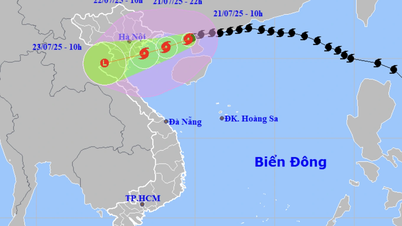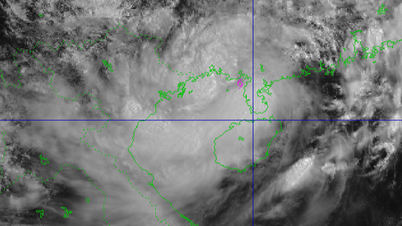The central exchange rate decreased by 18 VND, the VN-Index increased by 34.67 points compared to the previous weekend session, or the Consumer Price Index (CPI) in April increased mainly due to the impact of gasoline prices... are some notable economic information in the week from April 22-26.
| CPI in April 2024 increased by 4.4% over the same period last year. Review of economic information on April 25 |
 |
| Economic news review |
Overview
The consumer price index (CPI) in April increased mainly due to the impact of gasoline prices. Experts say that inflation in 2024 will likely be higher than in 2023, but still under control.
According to data released by the General Statistics Office on April 29, the increase in gasoline prices following world fuel prices was the main reason for the CPI in April 2024 to increase by 0.07% compared to the previous month. Thus, compared to December 2023, the CPI in April increased by 1.19% and compared to the same period last year, it increased by 4.4%. On average, in the first 4 months of 2024, the CPI increased by 3.93% compared to the same period last year.
In the 0.07% increase in CPI in April 2024 compared to the previous month, there were 8 groups of goods and services with increased price indexes, 3 groups of goods with decreased price indexes. Among the groups of goods and services with increased price indexes, the transportation group had the highest increase of 1.95% (making the overall CPI increase by 0.19 percentage points). This group had a high increase mainly due to the domestic gasoline price increasing by 4.78%; diesel price increasing by 2.01% due to the impact of price adjustments during the month.
In addition, air passenger transport prices increased by 10.42%; waterways increased by 0.06%; roads increased by 0.13%; buses increased by 0.21% and taxis increased by 0.56% due to the increase in gasoline prices. The group of medicines and medical services increased second highest, up 0.92% due to the changing weather, disease-causing viruses proliferating, the number of pneumonia, chickenpox, hand, foot and mouth disease cases increased rapidly, so people have a need to buy medicines to strengthen the immune system.
Of which, the price of pain relievers, antipyretics, and anti-inflammatories increased by 0.19%; anti-allergy and hypersensitivity drugs increased by 0.13%; cardiovascular drugs and some other products increased by 0.07%. The other goods and services group increased by 0.27% mainly due to the increase in prices of personal items (up 0.6%).
In April, the noteworthy factor, among the 3 groups of goods and services with a decrease in price index, the education group decreased by 2.93% compared to the previous month, contributing to a decrease in the general CPI by 0.18 percentage points, of which education services decreased by 3.32%. The main reason is that on December 31, 2023, the Government issued Decree No. 97/2023/ND-CP amending and supplementing a number of articles of Decree No. 81/2021/ND-CP dated August 27, 2021 of the Government, which requires localities to keep tuition fees stable from the 2023-2024 school year at the same level as the tuition fees of the 2021-2022 school year for public preschool and general education, accordingly, a number of schools have adjusted their tuition fees down after collecting them according to Decree No. 81/2021/ND-CP.
According to the newly released data, core inflation in April 2024 increased by 0.17% compared to the previous month and increased by 2.79% compared to the same period last year. On average, in the first 4 months of 2024, core inflation increased by 2.81% compared to the same period last year, lower than the average CPI (up 3.93%), mainly due to the prices of food, gasoline and medical services, which are factors affecting the increase in CPI but are excluded from the list of goods for calculating core inflation.
Commenting on inflation for the whole year of 2024, most organizations and experts believe that inflation in 2024 will likely be higher than in 2023, but still under control and the target set by the National Assembly and the Government is an average CPI of 4 - 4.5%. However, inflation statistics for the first 4 months of the year show that inflation risks still exist. The most worrying thing in price management this year is that the prices of some essential raw materials, goods and consumer services are forecast to fluctuate and increase, such as: gasoline prices, prices of some construction materials, and food prices.
Along with that, the implementation of the market price roadmap, the correct and full calculation of costs in the prices of goods and services priced by the State continue to be issues that need to be considered in 2024; the 6% increase in regional minimum wage from July 1, 2024 will cause the CPI to increase by about 0.03 percentage points.
However, there are still some factors that help reduce pressure on price levels such as: Vietnam has abundant food and foodstuff resources, meeting domestic consumption and export needs. Some tax support policies in 2024 will continue to be implemented, contributing to reducing input costs. In addition, global prices and inflation are cooling down; domestic money supply is increasing but money turnover is still slow, forecast at about 0.7-0.9 times..., which are also factors that help control inflation.
At the meeting of the Price Management Steering Committee to review price management and operation in the first quarter and orientation for price management in the remaining months of 2024 held on April 24, the Ministry of Finance updated 3 price management scenarios, respectively forecasting the average CPI to increase by about 3.64% compared to 2023 (scenario 1); increase by 4.05% (scenario 2) and increase by about 4.5% (scenario 3); the General Statistics Office forecasts the average CPI to be in the range of 3.5% - 4.5% (3 scenarios: 3.5%, 4.0% and 4.5%); the State Bank forecasts the average CPI in 2024 to increase by about 4 ± 0.5%.
Domestic market summary week from April 22-26
Foreign exchange market: During the week of April 22-26, the central exchange rate continued to be adjusted up by the State Bank of Vietnam in the first two sessions of the week and then decreased again. At the end of April 26, the central exchange rate was listed at 24,246 VND/USD, down 18 VND compared to the previous weekend session.
The State Bank of Vietnam's transaction office continues to list the USD buying rate at 23,400 VND/USD, while the USD selling rate is listed at 25,450 VND/USD through all sessions.
The interbank USD-VND exchange rate decreased again during the week of April 22-26. At the end of the session on April 26, the interbank exchange rate closed at 25,334 VND/USD, down 116 VND compared to the previous weekend session.
The dollar-dong exchange rate in the free market also decreased over the sessions last week. At the end of the session on April 26, the free exchange rate decreased by 150 VND for buying and 130 VND for selling compared to the previous weekend session, trading at 25,530 VND/USD and 25,630 VND/USD.
In the interbank money market during the week of April 22-26, interbank VND interest rates fluctuated with an upward trend in all terms. Closing on April 26, interbank VND interest rates were traded around: overnight 4.78% (+0.82 percentage points); 1 week 4.82% (+0.68 percentage points); 2 weeks 4.92% (+0.56 percentage points); 1 month 4.95% (+0.37 percentage points).
Interbank USD interest rates maintained slight increases and decreases across sessions for all terms. On April 26, the interbank USD interest rate closed at: overnight 5.24% (-0.01 percentage point); 1 week 5.31% (-0.02 percentage point); 2 weeks 5.38% (-0.02 percentage point) and 1 month 5.40% (-0.01 percentage point).
In the open market from April 22-26, in the mortgage channel, the State Bank bid for 14-day term with a volume of VND 122,000 billion, the interest rate in the first session of the week was 4.0%, increasing to 4.25% in the following sessions. There were VND 117,805.1 billion in winning bids and VND 32,865.1 billion in maturity last week.
The State Bank of Vietnam offered 28-day SBV bills for auction, bidding on interest rates in all sessions. At the end of the week, a total of VND11,400 billion were won, the interest rate increased from 3.73%/year to 3.75% and ended the week at 3.5%; VND26,500 billion matured last week.
Thus, the State Bank of Vietnam pumped a net VND 100,040 billion into the market last week through the open market channel, the volume of SBV bills in circulation decreased to VND 51,350 billion, the volume in circulation on the mortgage channel was VND 117,805.1 billion.
On the bond market on April 24, the State Treasury successfully mobilized VND5,596 billion/VND12,000 billion of government bonds called for bid (winning rate of 47%). Of which, the 5-year and 20-year terms mobilized the entire call volume, respectively VND3,000 billion and VND2,000 billion. The 10-year term mobilized VND236 billion/VND4,000 billion called for bid, the 15-year term mobilized VND360 billion/VND3,000 billion called for bid. The winning interest rate for the 5-year term was 1.61% (+0.11 percentage points compared to the previous auction), the 10-year term was 2.50% (+0.05 percentage points), the 15-year term was 2.68% (+0.03 percentage points), the 20-year term was 2.80% (+0.15 percentage points).
This week, on May 2, the State Treasury offered 10,000 billion VND in government bonds, of which 5-year and 15-year terms offered 3,000 billion VND/term, 7-year terms offered 500 billion VND, 10-year terms offered 2,500 billion VND, and 30-year terms offered 1,000 billion VND.
The average value of Outright and Repos transactions in the secondary market last week reached VND10,583 billion/session, up from VND8,953 billion/session the previous week. Government bond yields last week were differentiated between maturities. At the close of the session on April 26, government bond yields were trading around 1-year 1.85% (+0.01 percentage point compared to the previous session); 2-year 1.87% (+0.02 percentage point); 3-year 1.90% (+0.02 percentage point); 5-year 2.09% (-0.04 percentage point); 7-year 2.31% (-0.04 percentage point); 10-year 2.79% (-0.02 percentage point); 15-year 3.0% (-0.03 percentage point); 30-year 3.12% (unchanged).
The stock market recovered during the week of April 22-26. At the close of the session on April 26, the VN-Index stood at 1,209.52 points, up 34.67 points (+2.95%) compared to the previous weekend; the HNX-Index added 6.02 points (+2.73%) to 226.82 points; the UPCom-Index increased 1.60 points (+1.84%) to 88.76 points.
Market liquidity decreased, averaging nearly VND17,900 billion/session, down sharply from VND29,200 billion/session the previous week. Foreign investors continued to net sell more than VND1,230 billion on all three exchanges.
International News
The US Federal Reserve did not change its policy interest rate at its May meeting, while the US recorded many important economic indicators in recent days. At the meeting that ended yesterday, May 1, the Federal Open Market Committee (FOMC) stated that inflation has decreased over the past year but is still at a high level. The FOMC still shows its determination to achieve full employment and the 2.0% inflation target in the long run.
To achieve this goal, the FOMC decided to leave the target range for the federal funds rate unchanged at 5.25% to 5.50%, and will carefully evaluate incoming data in making future decisions about the federal funds rate. The FOMC does not believe that a reduction in the federal funds rate is appropriate until it has greater confidence that inflation is moving toward 2.0% on a sustained basis.
In addition, starting in June of this year, the FOMC will slow the pace of its balance sheet reduction, from a reduction of $65 billion/month to $25 billion/month. Regarding the US economy, GDP in this country increased by only 1.6% year-on-year in the first quarter of 2024, slowing down from the 3.4% rate in the previous quarter and at the same time lower than the forecast of 2.5%.
On the inflation front, the US core PCE price index rose 0.3% month-over-month in March, matching the increase in February and matching forecasts. Year-over-year, the core PCE rose 2.8% in March, unchanged from February.
However, the headline PCE rose 2.7% in March, up from 2.5% in February. In the labor market, the US created 8.49 million job openings in March, down from 8.81 million in February and also below the forecast of 8.68 million. In April, the country created 192 thousand new non-farm jobs (according to ADP), down from 208 thousand in March but more positive than the expectation of 179 thousand.
Next, the ISM survey said the US manufacturing PMI index was only 49.2% in April, down slightly from 50.3% in March and also below the forecast of 50%. Finally, the Conference Board surveyed the US consumer confidence index at 97.0 points in April, down from 103.1 points in March, contrary to the expectation of a slight increase to 104.0 points.
The Bank of Japan also left its policy rate unchanged at its meeting in late April. Last week, on April 26, the BoJ forecast that inflation in Japan would be around its 2.0% target by fiscal 2026. The agency decided to maintain the policy rate at 0.1%, unchanged from before.
More than a month ago, on March 19, the BoJ decided to raise its policy interest rate from -0.1% to 0.1%, ending its negative interest rate policy since 2016. The market believes that it is unlikely that the BoJ will continue to raise its policy interest rate strongly in 2024, despite the relatively large depreciation of the JPY against the USD and many other strong currencies. The main reason is that the country's economy has not really recovered and stabilized.
Regarding the Japanese economy, the country's core CPI inflation rose 2.2% year-on-year in March, slightly lower than the 2.3% increase recorded in the previous month. In the labor market, Japan's unemployment rate stood at 2.6% in March, unchanged from February, contrary to expectations of a slight decrease to 2.5%.
Next, Japan's industrial output rose 3.8% month-on-month in March after falling 0.6% in the previous month, beating forecasts for a 3.4% gain. Compared to the same month in 2023, March output still showed a 6.7% decline. Finally, retail sales in Japan rose 1.2% year-on-year in March, slowing sharply from February's 4.7% and also below forecasts for a 2.5% gain.
Source link

























![[Photo] National Assembly Chairman Tran Thanh Man visits Vietnamese Heroic Mother Ta Thi Tran](https://vphoto.vietnam.vn/thumb/1200x675/vietnam/resource/IMAGE/2025/7/20/765c0bd057dd44ad83ab89fe0255b783)












































































Comment (0)